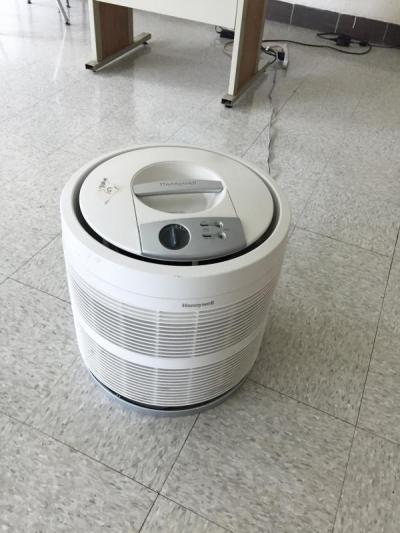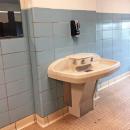Pandemic preparedness at Dartmouth Middle School
Schools are normally colorful, busy places, with artwork, maps, and educational posters on the walls and — of course — plenty of books.
But due to the coronavirus pandemic, Dartmouth Public Schools staff have been left scrambling to clear out buildings all over town in preparation for kids’ partial return in October.
According to School Business Administrator Jim Kiely and Facilities Director Richard Ferreira, four large containers have already been filled with furniture and left in the parking lot behind the middle school — and more storage containers are on their way.
And removing furniture for easier cleaning is just the tip of the iceberg.
The staff has been working since March to not only clear out items, but also ensure air movement and purification and purchase enough cleaning and personal protective equipment supplies. “We have eight tons of sanitizer,” Kiely said.
Hand sanitizing pumps sit in every hallway and classroom. Corridors have lanes and arrows marked out for one-way and through travel, with stairs, intersections and doorways carefully planned.
“It’s emptying stuff out, and...creating traffic patterns,” noted Superintendent of Schools Dr. Bonny Gifford. “It’s a new adventure. A new challenge.”
Classrooms themselves have been stripped of furniture, toys, globes, alternative seating, and other materials that don’t lend themselves to daily disinfection. The rooms are sparsely populated with desks spaced six feet apart. Bookcases will be covered to prevent kids from being able to touch and take materials out.
Lockers will be abandoned, as will the auditorium — it’s too difficult to keep clean and ensure social distancing, officials explained.
“There is a lot of thought we’ve put into a million things,” Kiely said. “It’s a lot.”
Students will also need more school supplies, since they won’t be able to share — extra everyday items like scissors, individual white boards, tape, paperclips, pens, and binders.
Water fountains will be capped to prevent drinking, although the bottle refill function will remain. Every other bathroom stall will be closed off. Lunches will have to be delivered to classrooms, presenting one of many logistical problems to solve.
Isolation spaces have been created in each school for students exhibiting symptoms as well. In the middle school, the isolation room is in a former reading specialist’s space. “Basically, the concept is to keep kids as far apart as possible, and have minimal furnishings in here to clean,” Kiely said.
He described the work as solving a series of problems that have never been solved before. “And then it’s on to the next one,” he said wryly.






















